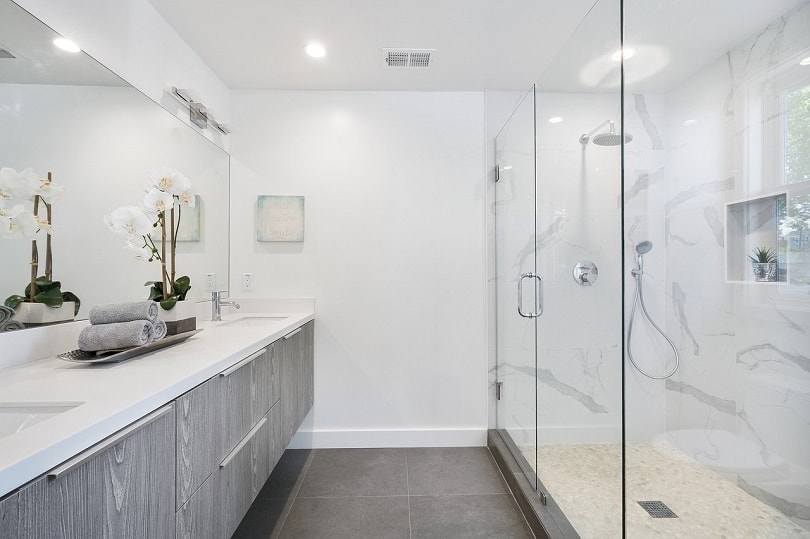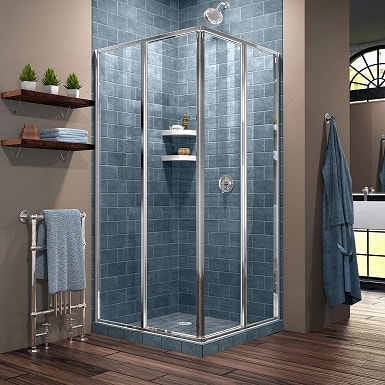Frameless vs. Framed Shower Doors: How to Choose
-
Pete Ortiz
- Last updated:

You may have thought you had your whole shower figured out until it came time to decide on an entryway. You know you want a glass door to show off your bathroom’s new focal point, but should you choose a frameless or a framed setup? Sometimes, the shape of your shower will dictate which one you need. Most of the time, both will be viable options. What is the difference between these two types of shower entries? Is one better than the other, or is it just a matter of aesthetic preference? We’re going to dive into all of this in this article, so by the end, you’ll be informed enough to make an educated decision about which one is best for your bathroom.
Frameless Shower Doors
In recent years, frameless shower doors (like the WOODBRIDGE pictured above) have exploded in popularity. When you see one, it’s pretty easy to see why. With no obtrusive metal frame surrounding the glass, a frameless shower door can have a very elegant look. Especially for custom tile showers, a frame can seriously detract from the overall looks of your shower. A frameless door, on the other hand, has no distractions to draw your eyes away from the big picture of the shower behind the door. If you want to really show off that custom shower, then a frameless door setup will allow you to do so in style.
While they’re very attractive, frameless shower doors are also much more difficult to install. A framed door has mounting points on both sides against the walls, as well as on the bottom to the floor. A frameless door doesn’t have as many mounting options. Some frameless setups still require a bar across the top for the doors to slide on, while others will mount to the wall using hinges and can be devoid of any metal aside from the handles and hinges.
Sliding Frameless Doors
Sliding frameless doors feature a single rail along the top that both of the doors will hang on. It allows them to slide past each other so that both the left and right sides of your shower can be opened. We like this versatility, but not everyone likes the look of the metal support bar. The doors also need a mounting system on them, increasing the amount of metal used overall.
Hinged Frameless Doors
Hinged frameless doors feature the least metal and most glass construction of any shower door since they only require the support of the floor and two hinges. One panel of glass will be a dead-panel, meaning it doesn’t open; it’s permanently installed in place. The other side will be a glass panel door that is mounted directly to the tile with two hinges. This style of door can provide the most open viewing experience, showing off the custom tile behind.
Semi-Frameless Doors
Semi-frameless shower door setups have a minimal amount of metal frame, usually on just two sides of the door. Often, this means there is a support bar on the top and a small U-channel on the bottom, in which the glass panels sit. These types of doors provide a similar experience to frameless, but they’re a bit easier to install. They’re also a bit less expensive than true frameless setups.
- Aesthetically pleasing
- Shows off your shower more
- Sliding, hinged, or semi-frameless options
- More difficult to install
- Won’t work in all shower types
- Tend to be more expensive
Framed Shower Doors
For a more cost-effective way to enter and exit your shower, framed shower doors, like the Dreamline Cornerview, provide a slightly more utilitarian approach. But this doesn’t mean they can’t be aesthetically pleasing doors. Some of them are nearly as attractive as the more expensive frameless versions. They’re much easier to install, which means you can save even more money since a contractor will generally charge less to install them. Moreover, you may even be able to install them yourself, saving you the most money overall.
As the name implies, framed shower doors feature a metal frame around the entire perimeter of the door that the glass panels themselves sit inside. This provides stability and strength at an affordable price since complex mounting systems are not required. What’s more, this means less chance of damaging your tiles during installation.
Similar to frameless setups, framed shower doors are available in hinged systems that pivot to open, as well as sliding systems that feature two panels that both move independently.
Sliding Framed Doors
Featuring two independently moving glass panels, framed sliding doors allow entry on both the left and right sides of your shower. The glass tucks into a small metal frame on all four sides. This makes it much easier to install than a frameless sliding door which has only a single rail for the doors to be mounted on.
Hinged Framed Doors
A framed shower door that pivots will feature one immovable glass panel and a single hinged door. A small metal frame will still surround the entire door, and the pivoting panel will seal up to the frame. These are one of the easiest types of shower doors to install, so you could very likely put it in yourself to save money.
- Can get sliding or hinged
- Less expensive
- Easier to install
- Doesn’t look as good
How to Decide Which is Best for You?
Now that we’ve discussed the strengths and weaknesses of framed and frameless shower doors, you may be wondering which one is best for your shower. Well, it comes down to a few important factors such as budget, aesthetics, and installation.
Frameless shower doors can cost considerably more than their framed-in cousins, so if the cost is your main concern, you’re probably going to be looking for a framed door. Even the installation of a frameless setup is likely to cost more.
When it comes to overall aesthetics, it’s hard to beat the elegance of a frameless system. With few metal parts to distract you from the beautiful tile behind, your shower will remain the focal point of your bathroom, not being hidden by the door.
As mentioned, installing a framed shower door is much easier. If you’re planning to install your new door yourself, we’d suggest picking a framed unit. Especially for someone with little to no experience, attempting to install a frameless shower door could be biting off more than you can chew.
Conclusion
At this point, we hope that you’ve learned enough to make an informed decision about which type of shower door is a better choice for you. Frameless doors are almost entirely glass with very few metal parts to take the focus away from the elegant tile behind. That said, they’re also more expensive and harder to install. On the other hand, framed shower doors are less expensive, and homeowners who have a little bit of DIY knowledge can install them. However, they’re not nearly as attractive, thanks to the metal frame that surrounds the glass. For the most affordable option or one that you can install yourself, we suggest a framed setup. If you want the most enriching viewing experience possible, then we’d recommend spending a bit more and getting a frameless system instead.
See Also:
- What are Sump Pumps, and How Do They Work?
- Should There Be Water in Your Sump Pump Pit?
- How Often Should a Sump Pump Run?
Featured Image Credit: 4001179, Pixabay
Contents






